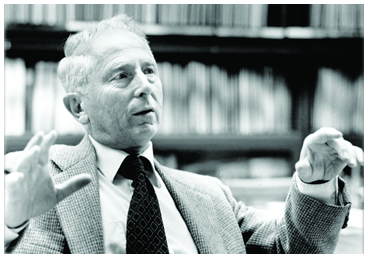Louis Rosen
- LANSCE User Office
- (505) 667-6797
 Louis Rosen, was the driving force behind the conception and the development of the Los Alamos Neutron Science Center (LANSCE). Louis directed LANSCE from its inception in 1972 until 1985. Louis continued to work at LANSCE until two days before his death in August of 2009. He was 91. Known as the Father of LANSCE, Louis is remembered for his tireless efforts, scientific achievements, humor, and compassion. Louis lives on in the hearts all who had the privilege to know him.
Louis Rosen, was the driving force behind the conception and the development of the Los Alamos Neutron Science Center (LANSCE). Louis directed LANSCE from its inception in 1972 until 1985. Louis continued to work at LANSCE until two days before his death in August of 2009. He was 91. Known as the Father of LANSCE, Louis is remembered for his tireless efforts, scientific achievements, humor, and compassion. Louis lives on in the hearts all who had the privilege to know him.
During the Manhattan Project, Louis Rosen learned from and worked side by side with the great scientists of the 20th century: Hans Bethe, Edward Teller, Stan Ulam, Nick Metropolis, John von Neumann and others. Louis' measurements turned out to be instrumental at Trinity, the first nuclear explosion on the planet. And later, at the George shot, Louis made the measurements that proved Teller's concept for a thermonuclear bomb would work. Steeped in the culture of those heroic times, Louis conceived of LANSCE as an interdisciplinary facility that would keep Los Alamos as the world leader in nuclear technology. It would be a place for fundamental science, ranging from nuclear medicine to astrophysics, and for innovation in technologies critical to national security.
Louis' vision was born of an epiphany he had in 1959, while on a Laboratory and Guggenheim Memorial Foundation-sponsored sabbatical in Paris. This vision was keenly focused on the future of nuclear science at both the Laboratory and in the nation. Louis believed that the Laboratory could not remain the cornerstone of national security without achieving international scientific excellence: the so-called "deterrence through competence" argument. In addition, meeting the broad challenges of national security required solving problems in, for example, energy security, medicine, environmental stewardship, and nuclear non-proliferation.
Louis understood that nuclear science played a key role in solving each of these challenges. His vision was to build the world's most advanced nuclear science facility based upon the world's most powerful, high-intensity-proton linear accelerator. This accelerator would be capable of producing Pi-mesons at intensities up to 10,000 times over anything then in use, making LAMPF a kind of Pi-meson factory. These mesons would be used to probe the structure and function of the nucleus and would keep Los Alamos at the forefront of nuclear physics for decades.
LANSCE continues to honor Louis' vision. Today, LANSCE strives to maintain a balance between the fundamental and applied nuclear, materials, biological, and defense sciences to help meet the complex challenges of national security.

